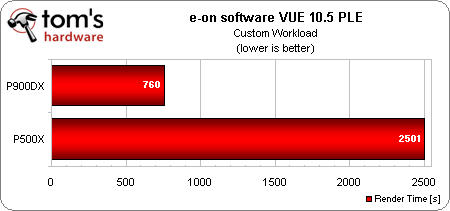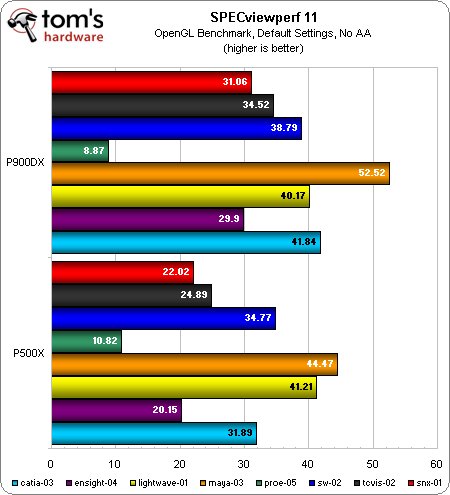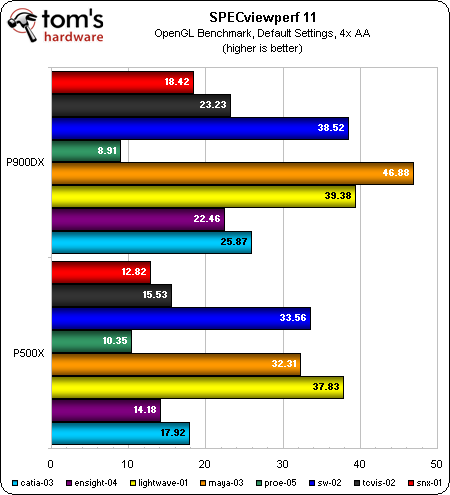iBuyPower P500X And P900DX Workstations, Reviewed
Armed with updated workstation benchmarks, we have two systems from iBuyPower in the lab today: a $2,000 quad-core entry-level rig, and an $8,000 sixteen-core behemoth. With $6,000 separating the two, is the performance spread really what you'd expect?
Rendering And 3D Animation: VUE, Blender, And SPECviewperf
e-on software Vue 10.5 PLE
e-on software’s Vue is a landscape renderer often used in addition to other 3D software to create realistic landscapes for 3D animation. Its tools are aimed specifically at landscape rendering, including procedural placement of vegetation and rocks across the landscape. Its system for instancing details is built into the software, making it easy to create beautiful scenery without having to build the landscapes using conventional 3D animation tools.
The 10.x revision of Vue features some pretty heavy revisions to the render engine, which actually result in increased render times compared to previous versions. Therefore, these numbers absolutely cannot be compared to earlier versions.
The P900DX comes out with a 3.3x lead over the P500X, which is in line with other 3D rendering results on these machines.
Blender
Blender is a 3D application with a bit of interesting history. It was originally developed as the in-house animation software for the Dutch studio NeoGeo. The primary author founded Not a Number (NaN) Technologies in 1998 to further develop and distribute the application. From 1998 until 2002, blender was distributed as shareware by NaN. Following NaN’s bankruptcy in 2002, Blender was purchased from NaN’s creditors for €100,000 and placed in the care of the Blender Foundation, which continues its development today. Blender is a fully capable free and open source (FOSS) 3D modeling, animation, and rendering package.
Our Blender test currently uses a custom workload rendered with the Cycles engine, rather than the older Tiles engine.
Get Tom's Hardware's best news and in-depth reviews, straight to your inbox.
The P900DX comes out with a substantial 110% lead over the P500X.
SPECviewperf 11
SPECviewperf is a composite test developed by the Graphics Performance Characterization working group of the Standard Performance Evaluation Corporation (also known as SPECgpc). The test aims to give an overall view of a system's real-time 3D performance. It includes modules that are built from the real-time display engines of animation and engineering software like CATIA, EnSight, LightWave 3D, Maya, Pro/Engineer, SolidWorks, and Siemens VisMockup and NX. We ran the tests with no anti-aliasing, as well as with 4x AA applied.
Some of the tests are clearly single-threaded, allowing the P500X’s higher clock rate and Ivy Bridge architecture to narrow the gap, and even make it the clear winner when there is no anti-aliasing applied.
Meanwhile, other tests give the edge to the P900DX, ranging from slight to substantial. Some of the application modules take a larger hit from full-screen anti-aliasing than others, and the P500X’s Quadro 2000 seems to take a larger hit from AA than the P900X's Quadro 4000.
Current page: Rendering And 3D Animation: VUE, Blender, And SPECviewperf
Prev Page Rendering And 3D Animation: Cinebench, LuxMark, And & SolidWorks Next Page Digital Audio Workstation Performance-
sprucegroose The P900DX would be about $6500 for the parts alone. It also comes with warranty, and if you are the type of person using it, the time building it and repairing it might offset the price difference. On the other hand, you could put in better components for the same price.Reply -
manitoublack We've got the Quadro 4000's at work and they're junk. GTX280 is faster and they were released in 2008. I pulled mine and installed my old GTX295, made a huge difference using the mine modelling software.Reply
Quadrao 4000 was all stutters, GTX 295 is buttery smooth. -
csf60 manitoublackWe've got the Quadro 4000's at work and they're junk. GTX280 is faster and they were released in 2008. I pulled mine and installed my old GTX295, made a huge difference using the mine modelling software.Quadrao 4000 was all stutters, GTX 295 is buttery smooth. that's because workstation cards are not meant to be fast at rendering frames. They are fast at doing many simple batch calculations like ray tracing, fluid movement or video editing.Reply -
j2j663 manitoublackWe've got the Quadro 4000's at work and they're junk. GTX280 is faster and they were released in 2008. I pulled mine and installed my old GTX295, made a huge difference using the mine modelling software.Quadrao 4000 was all stutters, GTX 295 is buttery smooth.Reply
This is like someone complaining that a screwdriver is really bad at pounding in nails. Learn to use the right tools for the job at hand. -
I'm curious about the After Effects performance. What were your memory settings when rendering multiple frames simultaneously?Reply
-
Draven35 they varied, I had to set them between 3gb and the minimum in order to the the maximum number of cores. I have a working theory on the AE problem that i will test next opportunity.Reply -
Wow, odd. Anywhere I could get an update on your progress once you test your hypothesis? I'd love to figure out what is causing that result. It should be destroying that benchmark.Reply



